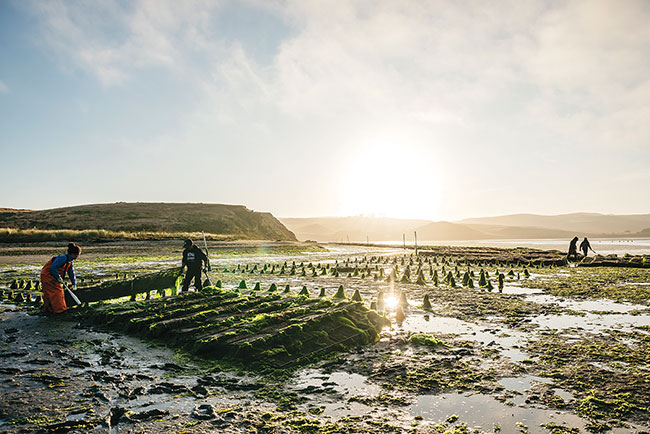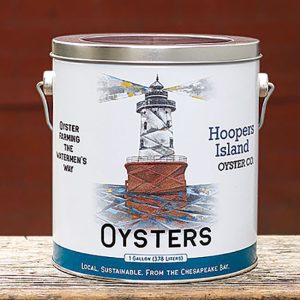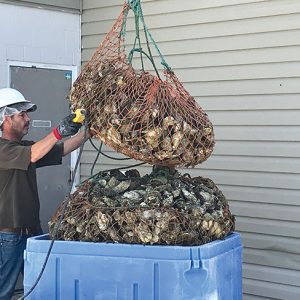
Prospects are looking up for oyster growers
February 18, 2022
By Julia Hollister
Many are optimistic about continued recovery despite lingering issues
 Hog Island Oyster Farm in Tomales Bay in Marin County, California. Oyster growers are confident they are more equipped to deal with this wave of the pandemic because of the adaptations they made earlier Photo: Remy Hale
Hog Island Oyster Farm in Tomales Bay in Marin County, California. Oyster growers are confident they are more equipped to deal with this wave of the pandemic because of the adaptations they made earlier Photo: Remy Hale The COVID-19 pandemic has entered a new phase which offers what the World Health Organization calls “a plausible hope for stabilization.” It is a sentiment shared by oyster farmers, who bore the brunt of the damage caused by restaurant closures in phase one of the pandemic.
Despite the labour shortages and disruption in the supply chain, oyster growers are confident they are more equipped to deal with this wave because of the adaptations they made earlier.
San Francisco-based Hog Island Oysters, which raises four million oysters annually on 150 saltwater acres in Tomales Bay, increased outdoor dining at its five restaurants and ramped up its direct-to-consumer business during the first wave. It now has a robust direct-to-consumer department as a direct result of its early-COVID pivot.
But while these have helped, CEO John Finger anticipates some continuing disruptions in terms of labor availability.
“During the current Omicron wave, we’ve been extremely short handed at our farm and restaurants due to difficulty filling positions. Additionally, we’ve had employees out with COVID-19. It has definitely affected the level of business at our restaurants as well,” he said.
Brie Mazurek, communications director of the Center for Urban Education about Sustainable Agriculture, applauded Hog Island Oysters and other local farmers “for continuing to provide a vital lifeline to bring fresh, local seafood directly to the public” during this difficult time.
“We have been proud to partner with Hog Island to bring their high-quality, sustainably farmed shellfish to our Bay Area community at the Ferry Plaza Farmers Market for more than two decades. With disruptions to restaurants, the pandemic has been especially hard on local farms and aquaculture,” said Mazurek.
Alaska Shellfish Farms in Halibut Cove, AK, is seeing fluctuating sales. Oyster consumption in restaurants is down because customers aren’t dining out, said owner, Weatherly Bates.
She noted, however, that oyster shortages in other states due to climate-induced farm closures have boosted demand for oysters from Alaska, where water is colder.
Michael Mastin of Hump Island Oyster Co. in Ketchikan, Alaska, is seeing steady sales.
“Our wholesale customers are placing orders at similar levels as last year, taking seasonal variations into account,” he said. “Winter-season orders are down significantly compared to our summer tourism market and pre-COVID. But, seasonal variations are normal for us.”
Mastin said he is seeing more farm-tour bookings than this period last year.
Charlie Phillips, owner of Sapelo Sea Farms in Townsend, GA, harvests wild oysters and farms clams while waiting for his oyster permits to come through. “I am optimistic about 2022 and a good, strong summer; but then again, a lot can go wrong with the economy,” he said. “It’s also still pretty tough to find enough help to do the work.”
In Grand Isle, Louisiana, Nathan Herring of Bright Side Oyster Co. says damage from the pandemic doesn’t even compare to the damage from the hurricane last August.
“Hurricane Ida, a Category 5 hurricane, smashed the oyster business. Around 80 percent of our oysters died when they were smothered in the mud,” said Herring. “We are still recovering. We began home deliveries for our customers because people are eating at home and not in restaurants.”
Still, he is hopeful. “I hope we can plant more seed oysters and sell them by the end of the year.”
At Hollywood Oyster Co., one of Maryland’s largest oyster farms, the impact of the Omicron wave has been negligible so far, said Tal Petty, owner of the business.
“In fact, there are more customers during this wave. We’ve been pleased by the resilience of restaurants and their customers.”
Petty said the farm is going into the year with good growing inventory and demand for farmed oysters.
Meanwhile, business is going smoothly at Hoopers Island Oysters in Cambridge, Maryland.
“Fortunately we have several business units, all of which are doing well at the present time,” said David Vincent, director of business development.
The company is an oyster farmer and manufacturer of oyster aquaculture equipment. Vincent said the COVID relief funds that farmers received helped boost orders for its farming equipment. For its part, Hoopers used the relief funds it secured to retain staff and develop online sales.
“We have recently opened a retail store in conjunction with our online marketing efforts to grow our brand name. While this is largely focused on retail sales, it added to our credibility as a commercial supplier.”
Vincent added that online sales have been on the rise over the two years since the onset of the pandemic. But he noted that online sales are still only a small percentage of the total annual revenue.
“We are very optimistic about 2022,” said Vincent. We certainly have things to improve on, but we project a strong year for equipment and oyster orders.”
Advertisement
- Analytics, genetics tech chart new direction for aquaculture
- Biosecurity: critically important or just another dirty word?







